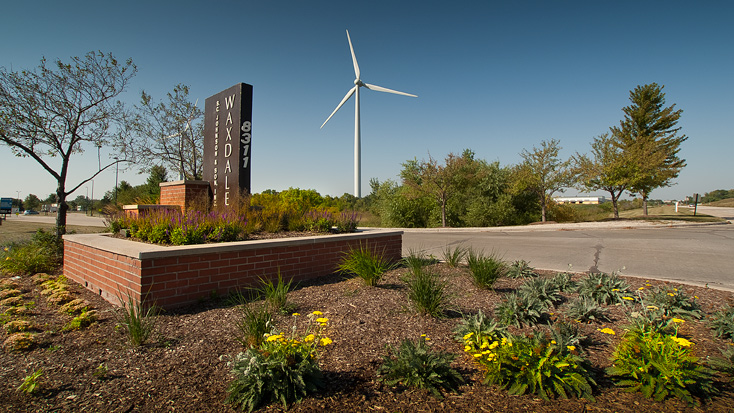After one year, two wind turbines at its largest manufacturing facility have cut nearly 6,000 metric tons of greenhouse gas emissions.

Over the past decade, the company has undertaken 10 renewable energy initiatives around the globe, including wind power, solar, and cogeneration.
SC Johnson recently celebrated the anniversary of one renewable energy investment: two wind turbines at the company’s largest manufacturing facility, Waxdale, in Mt. Pleasant, Wis. These turbines have successfully cut nearly 6,000 metric tons of greenhouse gases in their first year. Combined with the site’s cogeneration systems already in place, the Waxdale facility, which is the size of 36 football fields, is now able to generate, on average, 100% of its electrical energy onsite.
The wind power from these turbines significantly contribute to SC Johnson’s renewable energy goals. The company recently reported that it is on track to reach its five-year goal of sourcing 33% of its global energy from renewable sources.
“As a family company, SC Johnson has long been committed to reducing its environmental footprint, and investing in renewable energy is a critical part of our business strategy,” said Kelly M. Semrau, Chief Sustainability Officer at SC Johnson. “The results achieved with the wind turbines at our Waxdale facility are just one example that demonstrate our desire to lessen our footprint and positively impact communities around the world.”
Over the past decade, the company has undertaken 10 renewable energy initiatives around the globe, including wind power, solar, and cogeneration. These initiatives have reduced greenhouse gas emissions by more than 110,500 metric tons per year, which is equivalent to the emissions from:
- 23,021 passenger vehicles or
- the total energy use of 5,519 homes for one year or
- 15,204 homes’ electricity use for one year or
- 4,604,167 propane tanks used for home barbeque grills**
Renewable energy results at Waxdale
In December 2012, SC Johnson commissioned two Vensys 1.5 MW turbines with 82m torots at Waxdale, in Mt. Pleasant, Wis., and one year later, the results are impressive. The wind turbines have produced nearly 8 million kWh since December 2012 — enough energy to power 700 homes over the course of a year.*
Coupled with the cogeneration system that SC Johnson installed in 2003, which cuts 47,250 metric tons of greenhouse gas emissions per year, Waxdale now produces 100%, on average, of its electrical energy on-site. Waxdale is currently the site of the largest company-owned wind turbine manufacturing project in the Midwest.
A commitment to global renewable energy
In addition to the wind energy and cogeneration projects in Mt. Pleasant, Wis., the company’s renewable energy initiatives span the globe:
- Solar projects in Shanghai, China provide hot water heating for several company operations and cut 70 metric tons of greenhouse gas emissions annually.
- A wind-power initiative in Toluca, Mexico lets the facility receive 86% of its electricity from renewable sources, which cuts 3,000 metric tons of greenhouse gas emissions annually.*
- The company’s first owned wind turbine in Mijdrecht, The Netherlands was installed in 2009 and now generates 50% of the electricity for the local facility while cutting 2,100 metric tons of greenhouse gas emissions annually.*
- The use of waste palm oil shells in Medan, Indonesia serves as a fuel source to heat water, which reduces local diesel use by 80% and transfers waste back to the value chain. This cuts 6,000 metric tons of greenhouse gas emissions annually.*
- A biofuel initiative in Surabaya, Indonesia uses waste husks from rice grains as a fuel source for heating water used in mosquito coil production, which cuts 7,090 metric tons of greenhouse gas emissions annually.*
SC Johnson
www.scjohnson.com
Filed Under: News




